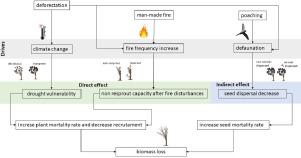Ecological Modelling ( IF 2.6 ) Pub Date : 2021-06-01 , DOI: 10.1016/j.ecolmodel.2021.109628 Everton A. Maciel , Valeria F. Martins , Mateus D. de Paula , Andreas Huth , Frederico A.G. Guilherme , Rico Fischer , André Giles , Reinaldo I. Barbosa , Osmar Cavassan , Fernando R. Martins

|
As a result of anthropogenic pressure, three drives are expected to affect Brazilian savannas: an increase in the dry season, more frequent fire events, and defaunation. These drivers are a trigger for biodiversity loss and undermine the ecosystems services like carbon storage. Here our goal was to analyze how these drivers can affect the structure and dynamics of the savanna's tree species and how they impact the savanna's total estimating aboveground biomass (AGB). We analysed eight sites that comprise a physiognomic gradient from open savanna to savanna woodland. The species were classified by three traits: phenological strategies (deciduous or evergreen), fire resistance (resprouting or non-resprouting), and dispersal syndrome (animal or non-animal). Then, we modelled AGB loss in a dry season in the austral winter, a 2 °C increase in daily temperature, five fire events by decadal-series, and a defaunation scenario. Although climate change, change in fire frequency, and defaunation effects impact AGB separately, they also have a synergistic effect. This effect was observed in functional strategies and also in the total AGB of the community. In some cases, the total AGB loss exceeded 70%. The negative effects on performance were highest in species which were decidual, non-resprouting, and which employed animal dispersal for their seed. If different types of disturbances are not controlled in the near future, savanna communities will be dominated by evergreen, resprouters, and non-animal dispersed species, representing a steeply decline in the diversity of species and ecosystem functions.
中文翻译:

动物区系丧失以及气候和火灾频率的变化对巴西稀树草原的地上生物量损失具有协同作用
由于人为压力,预计三个驱动因素将影响巴西热带稀树草原:旱季增加、火灾事件更频繁和动物区系丧失。这些驱动因素是生物多样性丧失的触发因素,并破坏了碳储存等生态系统服务。在这里,我们的目标是分析这些驱动因素如何影响稀树草原树种的结构和动态,以及它们如何影响稀树草原的总估计地上生物量 (AGB)。我们分析了八个地点,这些地点包括从开阔的稀树草原到稀树草原林地的地貌梯度。该物种按三个特征分类:物候策略(落叶或常绿)、耐火性(重芽或不重芽)和传播综合征(动物或非动物)。然后,我们模拟了南方冬季旱季的 AGB 损失,每日温度升高 2 °C、十年系列的五次火灾事件以及动物区系丧失情景。尽管气候变化、火灾频率变化和动物区系丧失效应分别影响 AGB,但它们也具有协同效应。在功能策略和社区的总 AGB 中观察到这种效果。在某些情况下,总 AGB 损失超过 70%。对性能的负面影响在落叶、不发芽和使用动物散播种子的物种中最高。如果近期不控制不同类型的干扰,稀树草原群落将以常绿、再芽和非动物分散物种为主,代表物种多样性和生态系统功能的急剧下降。和动物区系灭绝场景。尽管气候变化、火灾频率变化和动物区系丧失效应分别影响 AGB,但它们也具有协同效应。在功能策略和社区的总 AGB 中观察到这种效果。在某些情况下,总 AGB 损失超过 70%。对性能的负面影响在落叶、不发芽和使用动物散播种子的物种中最高。如果近期不控制不同类型的干扰,稀树草原群落将以常绿、再芽和非动物分散物种为主,代表物种多样性和生态系统功能的急剧下降。和动物区系灭绝场景。尽管气候变化、火灾频率变化和动物区系丧失效应分别影响 AGB,但它们也具有协同效应。在功能策略和社区的总 AGB 中观察到这种效果。在某些情况下,总 AGB 损失超过 70%。对性能的负面影响在落叶、不发芽和使用动物散播种子的物种中最高。如果近期不控制不同类型的干扰,稀树草原群落将以常绿、再芽和非动物分散物种为主,代表物种多样性和生态系统功能的急剧下降。在功能策略和社区的总 AGB 中观察到这种效果。在某些情况下,总 AGB 损失超过 70%。对性能的负面影响在落叶、不发芽和使用动物散播种子的物种中最高。如果近期不控制不同类型的干扰,稀树草原群落将以常绿、再芽和非动物分散物种为主,代表物种多样性和生态系统功能的急剧下降。在功能策略和社区的总 AGB 中观察到这种效果。在某些情况下,总 AGB 损失超过 70%。对性能的负面影响在落叶、不发芽和使用动物散播种子的物种中最高。如果近期不控制不同类型的干扰,稀树草原群落将以常绿、再芽和非动物分散物种为主,代表物种多样性和生态系统功能的急剧下降。











































 京公网安备 11010802027423号
京公网安备 11010802027423号